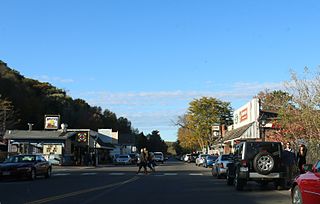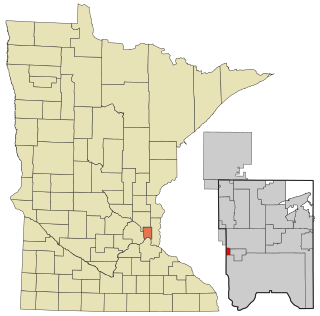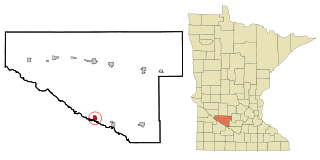
St. Clair or Saint Clair is a city in Blue Earth County, Minnesota, United States, located along the Le Sueur River. The population was 750 at the 2020 census. It is part of the Mankato-North Mankato Metropolitan Statistical Area.

Lindström is a city in Chisago County, Minnesota, United States, located 35 miles northeast of the Twin Cities. The population was 4,888 at the 2020 census. Lindström's motto is America's Little [Sweden]. U.S. Highway 8 serves as a main route for the community.

Taylors Falls is a city in Chisago County, Minnesota, United States, located at the junction of U.S. Highway 8 and Minnesota State Highway 95. The population was 1,055 at the 2020 census.

Wahkon is a city in Mille Lacs County, Minnesota, United States. The population was 235 as of the 2020 census, up from 206 in 2010.

Lauderdale is a city in Ramsey County, Minnesota, United States. The population was 2,379 at the 2010 census. Lauderdale is part of the Minneapolis–St. Paul metropolitan area and is bordered by Minneapolis, St. Paul, Roseville, and Falcon Heights. Along with Roseville, it is one of two cities to be bordered directly by Minneapolis and St. Paul.

Walnut Grove is a city in Redwood County, Minnesota, United States. The population was 871 at the 2010 census. Another name formerly associated with the area is Walnut Station.

Morton is a city in Renville County, Minnesota, United States. This city is ninety-five miles southwest of Minneapolis. It is the administrative headquarters of the Lower Sioux Indian Reservation. The population was 411 at the 2010 census.

Freeport is a city in Stearns County, Minnesota, United States. The population was 632 at the 2010 census. Freeport is part of the St. Cloud Metropolitan Statistical Area.

Dellwood is a city in Washington County, Minnesota, United States and a suburb of St. Paul. The population was 1,063 at the 2010 census.

Grant is a city in Washington County, Minnesota, and a suburb of St. Paul. The population was 4,096 at the time of the 2010 census.

St. Paul Park or Saint Paul Park is a city in Washington County, Minnesota, United States. The population was 5,279 at the 2010 census. It is on the east bank of the Mississippi River, five miles (8 km) downstream from St. Paul.

Lewiston is a city in Winona County, Minnesota, United States. The population was 1,620 at the 2010 census.

Center City is a city and the county seat of Chisago County, Minnesota, United States. The population was 628 at the 2010 census.

Falcon Heights is a suburb of Saint Paul and a city in Ramsey County, Minnesota, United States. The population was 5,321 at the 2010 census. It became a village in 1949 and a city in 1973.

White Americans are Americans who identify as white people. In a more official sense, the U.S. Census Bureau, which collects demographic data on Americans, defines "white" as "A person having origins in any of the original peoples of Europe, the Middle East, or North Africa." This group constitutes the majority of the people in the United States. According to the 2020 census, 71%, or 235,411,507 people, were White alone or in combination, and 61.6%, or 204,277,273 people, were White alone. This represented a national white demographic decline from a 72.4% white alone share of the U.S. population in 2010.
The demographics of the Bronx are characterized by a Hispanic majority and by the lowest percentage of Whites among all boroughs.

The demographics of Minnesota are tracked by the United States Census Bureau, with additional data gathered by the Minnesota State Demographic Center. According to the most recent estimates, Minnesota's population as of 2020 was approximately 5.7 million, making it the 22nd most populous state in the United States. The total fertility rate in Minnesota was roughly 1.87 in 2019, slightly below the replacement rate of 2.1.

The demographics of Minneapolis are tracked by the United States Census Bureau, with additional data gathered by the Minnesota State Demographic Center and the City of Minneapolis itself. Minneapolis is the largest city in the U.S. state of Minnesota and the county seat of Hennepin County.

According to the U.S. Census Bureau, as of 2020, the state of Oklahoma had a population of 3,959,353, which is an increase of 208,002 or 5.54% since the year 2010. Oklahoma is the 28th most populous state in the United States.
Tulsa is the second largest city of the U.S. state of Oklahoma and the county seat of Tulsa County. The city was estimated in 2011 by the U.S. Census Bureau to have 396,466 residents.

















